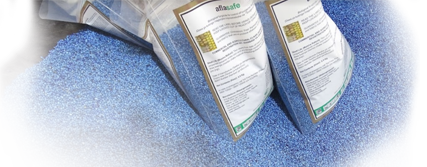Opening closed doors Groundnut exports: an income phoenix Safety standards and demand on the rise at home
Opening closed doors
 Aflatoxin limits domestic, regional and international trade, but we can take those brakes off. Aflasafe and the production of aflatoxin-safe foods offer a big income opportunity to both export businesses and national governments. Lucrative foreign markets, such as the European Union and the United States, have stringent aflatoxin limits. African groundnuts, maize and other crops are frequently contaminated with high levels of the toxin, effectively closing these valuable markets to African exports. Africa goes without significant income from lost export opportunities due to aflatoxin.
Aflatoxin limits domestic, regional and international trade, but we can take those brakes off. Aflasafe and the production of aflatoxin-safe foods offer a big income opportunity to both export businesses and national governments. Lucrative foreign markets, such as the European Union and the United States, have stringent aflatoxin limits. African groundnuts, maize and other crops are frequently contaminated with high levels of the toxin, effectively closing these valuable markets to African exports. Africa goes without significant income from lost export opportunities due to aflatoxin.
This makes aflatoxin a huge barrier between Africa and cherished foreign markets. Aflatoxin contamination is currently the number one reason for African agricultural products to be rejected by the European Union.
In the case of Nigeria, for example, between 1980 and 2016 a total of 389 Nigerian agricultural export shipments were rejected or seized by the EU, and in 39% of cases this was due to aflatoxin contamination. Meanwhile, in Uganda alone, aflatoxin is estimated to cost the country at least USD 38 million every year in lost export opportunities.
The good news is that these closed doors are ready to open as soon as we can guarantee reliably aflatoxin-safe commodities. Buyers are keen to purchase African products; confectionary companies, for example, are eager to secure supplies of groundnuts.
Buyers in wealthy countries today tend to be unwilling to take the risk on African products. For every shipment that is found to be contaminated, we lose not only the income from that shipment, but we damage the reputation of our exports, making even aflatoxin-safe products hard to sell.
 With Aflasafe, we no longer need to lose out. It offers us the opportunity to produce reliably aflatoxin-safe food, rebuild our relationships with importers and generate hundreds of millions of dollars for African economies, contributing to ongoing growth and stability. A World Bank study has found that that cutting aflatoxin contamination would add USD 281 million each year to groundnut exports in Senegal alone – read on for more on the power of groundnuts. The story is equally shocking in other nations. Malawi loses out on about USD 88 million every year in maize and groundnut exports, while Uganda goes without at least USD 78 million from maize alone.
With Aflasafe, we no longer need to lose out. It offers us the opportunity to produce reliably aflatoxin-safe food, rebuild our relationships with importers and generate hundreds of millions of dollars for African economies, contributing to ongoing growth and stability. A World Bank study has found that that cutting aflatoxin contamination would add USD 281 million each year to groundnut exports in Senegal alone – read on for more on the power of groundnuts. The story is equally shocking in other nations. Malawi loses out on about USD 88 million every year in maize and groundnut exports, while Uganda goes without at least USD 78 million from maize alone.
Groundnut exports: an income phoenix
Groundnut exports from Africa are currently low – and the finger of blame points at aflatoxin. In the years before Aflasafe was developed, several multinational purchasers, such as Mars, Nestlé and Intersnack, repeatedly reached out to IITA researchers in search of a solution to aflatoxin contamination. None are currently sourcing significant amounts of groundnuts from Africa, but all would very much like to, being keen to diversify their supply bases with groundnut prices predicted to rise. Every one of these companies agree that aflatoxin is by far the number one issue preventing them buying African groundnuts.
 Yet African countries, particularly in West Africa, were once the world’s major exporters of groundnuts, and these provided huge contributions to national incomes. In the 1960s and 70s, groundnuts supplied around two-thirds of export revenues in The Gambia, and 80% in Senegal. Groundnuts were even a tourist attraction: people flocked to northern Nigerian cities such as Kano to see sacks stacked high into imposing groundnut pyramids, a symbol of plenty and prosperity.
Yet African countries, particularly in West Africa, were once the world’s major exporters of groundnuts, and these provided huge contributions to national incomes. In the 1960s and 70s, groundnuts supplied around two-thirds of export revenues in The Gambia, and 80% in Senegal. Groundnuts were even a tourist attraction: people flocked to northern Nigerian cities such as Kano to see sacks stacked high into imposing groundnut pyramids, a symbol of plenty and prosperity.
In the 1980s and 90s this income stream dwindled dramatically and has not yet bounced back. For example, in Nigeria groundnut exports plummeted from a high of 291,000 tonnes in 1970 to just 1,983 tonnes in 2013. Senegal produced nearly a quarter of the world’s groundnut exports in the 1960s, and only around 1% in 2013. The reasons were complex, but one of the major factors was the growing awareness of aflatoxin contamination, and the introduction of strict safety standards that African exporters could not meet. Interviews with importers in countries such as the Netherlands and the United Kingdom confirm that, when choosing suppliers, reputation for compliance with aflatoxin standards is an important factor. In short, as importers started taking notice of aflatoxin, those plentiful pyramids faded away.
While no-one is seeking a return to almost exclusive reliance on groundnuts, across Africa we are increasingly recognising the need for diverse, sustainable income streams, and renewed groundnut exports are one great place to start. Global demand for groundnuts is growing, with importers seeking a high-quality, consistent supply, and if we are to reclaim a substantial share of lucrative markets we must bring aflatoxin under control.
Aflasafe offers a cost-effective and reliable solution to keep aflatoxin levels below the safety standards required by importers. Working with our partners on the ground, we are confident of bringing back the glory days of groundnut wealth.
Safety standards and demand on the rise at home
Aside from lost exports further afield, aflatoxin contamination puts a damper on regional and local trade within Africa as our products fail to meet our own standards, making it difficult to develop a thriving regional trade network. In 2018, for example, Kenya reportedly rejected 600,000 metric tonnes of maize imports from Uganda over fears of contamination, as well as impounding a large shipment from Mozambique.
Demand for aflatoxin-safe food is growing at home in Africa. Premium domestic markets are increasingly conscious of contamination, and are closing their doors to aflatoxin-contaminated products. For example, in 2015, the Cereal Millers Association of Kenya, representing 80% of the country’s maize meal industry, formally joined the Aflatoxin Proficiency Testing and Control in Africa programme of testing and labelling. As awareness of aflatoxin continues to expand, contamination will be an ever-more important obstacle to regional trade.
 At the same time, premium and processed-food markets are growing rapidly. With food safety a prerequisite for profit, this makes both aflatoxin-safe processed foods and the staples needed to make them increasingly essential and lucrative opportunities for traders.
At the same time, premium and processed-food markets are growing rapidly. With food safety a prerequisite for profit, this makes both aflatoxin-safe processed foods and the staples needed to make them increasingly essential and lucrative opportunities for traders.
We know that many firms are already casting eager nets locally and regionally, seeking sources of low-aflatoxin grain within Africa – particularly where high standards of safety are critical, such as in producing therapeutic foods for malnutrition. Africa Improved Foods in Rwanda is just one example.
In Nigeria too, aflatoxin is a crucial factor for numerous food-processing firms, whose imports from abroad are growing as local supply fails to meet their needs. We have found growing demand in Nigeria for maize treated with Aflasafe to keep aflatoxin levels low.
For traders and producers with an eye on the future, opportunities within Africa are flourishing. Aflasafe ensures a reliable supply of aflatoxin-safe products, the key to accessing high-paying markets, both at home and abroad.
Return to the industry and economics page to find out about aflatoxin’s impact in other sectors, and how Aflasafe offers a more prosperous, safer future.










